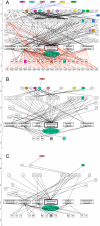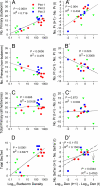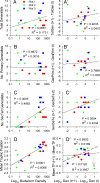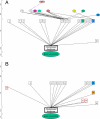Fluctuations in density of an outbreak species drive diversity cascades in food webs
- PMID: 17940003
- PMCID: PMC2040472
- DOI: 10.1073/pnas.0704301104
Fluctuations in density of an outbreak species drive diversity cascades in food webs
Abstract
Patterns in food-web structure have frequently been examined in static food webs, but few studies have attempted to delineate patterns that materialize in food webs under nonequilibrium conditions. Here, using one of nature's classical nonequilibrium systems as the food-web database, we test the major assumptions of recent advances in food-web theory. We show that a complex web of interactions between insect herbivores and their natural enemies displays significant architectural flexibility over a large fluctuation in the natural abundance of the major herbivore, the spruce budworm (Choristoneura fumiferana). Importantly, this flexibility operates precisely in the manner predicted by recent foraging-based food-web theories: higher-order mobile generalists respond rapidly in time and space by converging on areas of increasing prey abundance. This "birdfeeder effect" operates such that increasing budworm densities correspond to a cascade of increasing diversity and food-web complexity. Thus, by integrating foraging theory with food-web ecology and analyzing a long-term, natural data set coupled with manipulative field experiments, we are able to show that food-web structure varies in a predictable manner. Furthermore, both recent food-web theory and longstanding foraging theory suggest that this very same food-web flexibility ought to be a potent stabilizing mechanism. Interestingly, we find that this food-web flexibility tends to be greater in heterogeneous than in homogeneous forest plots. Because our results provide a plausible mechanism for boreal forest effects on populations of forest insect pests, they have implications for forest and pest management practices.
Conflict of interest statement
The authors declare no conflict of interest.
Figures




Similar articles
-
Barcoding a quantified food web: crypsis, concepts, ecology and hypotheses.PLoS One. 2011;6(7):e14424. doi: 10.1371/journal.pone.0014424. Epub 2011 Jul 6. PLoS One. 2011. PMID: 21754977 Free PMC article.
-
Spatial patterns of hyperparasitism along a latitudinal gradient of forest genus diversity: insights from the spruce budworm-parasitoids community.Environ Entomol. 2024 Feb 20;53(1):116-126. doi: 10.1093/ee/nvad110. Environ Entomol. 2024. PMID: 38006330
-
Insect-mediated apparent competition between mammals in a boreal food web.Proc Natl Acad Sci U S A. 2021 Jul 27;118(30):e2022892118. doi: 10.1073/pnas.2022892118. Proc Natl Acad Sci U S A. 2021. PMID: 34282006 Free PMC article.
-
Impact of nitrogen deposition on forest and lake food webs in nitrogen-limited environments.Glob Chang Biol. 2016 Jan;22(1):164-79. doi: 10.1111/gcb.12967. Epub 2015 Jun 19. Glob Chang Biol. 2016. PMID: 25953197 Review.
-
Paradigms in Eastern Spruce Budworm (Lepidoptera: Tortricidae) Population Ecology: A Century of Debate.Environ Entomol. 2016 Dec;45(6):1333-1342. doi: 10.1093/ee/nvw103. Epub 2016 Sep 1. Environ Entomol. 2016. PMID: 28028079 Review.
Cited by
-
Food web expansion and contraction in response to changing environmental conditions.Nat Commun. 2012;3:1105. doi: 10.1038/ncomms2098. Nat Commun. 2012. PMID: 23033081
-
Breeding matters: Natal experience influences population state-dependent host acceptance by an eruptive insect herbivore.PLoS One. 2017 Feb 16;12(2):e0172448. doi: 10.1371/journal.pone.0172448. eCollection 2017. PLoS One. 2017. PMID: 28207862 Free PMC article.
-
Development of a qPCR-based method for counting overwintering spruce budworm (Choristoneura fumiferana) larvae collected during fall surveys and for assessing their natural enemy load: a proof-of-concept study.Pest Manag Sci. 2022 Jan;78(1):336-343. doi: 10.1002/ps.6645. Epub 2021 Oct 21. Pest Manag Sci. 2022. PMID: 34529882 Free PMC article.
-
The complete genome of a baculovirus isolated from an insect of medical interest: Lonomia obliqua (Lepidoptera: Saturniidae).Sci Rep. 2016 Jun 10;6:23127. doi: 10.1038/srep23127. Sci Rep. 2016. PMID: 27282807 Free PMC article.
-
Environmental proteomics, biodiversity statistics and food-web structure.Trends Ecol Evol. 2012 Aug;27(8):436-42. doi: 10.1016/j.tree.2012.03.001. Epub 2012 Mar 27. Trends Ecol Evol. 2012. PMID: 22459246 Free PMC article.
References
-
- Daily GC, Alexander S, Ehrlich PR, Goulder L, Lubchenco J, Matson PA, Mooney HA, Postel S, Schneider SH, Tilman D, et al. Issues Ecol. 1977;1:1–18.
-
- Elton CS. The Ecology of Invasions by Animals and Plants. New York: Kluwer; 1958.
-
- Pimm SL. The Balance of Nature: Ecological Issues in the Conservation of Species and Communities. Chicago: Univ Chicago Press; 1991.
-
- May RM. Stability and Complexity in Model Ecosystems. Princeton: Princeton Univ Press; 1974.
-
- McCann KS. Nature. 2000;405:228–233. - PubMed
Publication types
MeSH terms
LinkOut - more resources
Full Text Sources
Other Literature Sources

